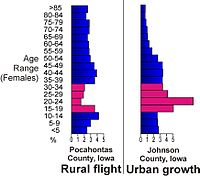
Photo from wikipedia
Background Internal medicine (IM) doctors in Japan play the role of primary care physicians; however, the shortage of rural physicians continues. This study aims to elucidate the association of age,… Click to show full abstract
Background Internal medicine (IM) doctors in Japan play the role of primary care physicians; however, the shortage of rural physicians continues. This study aims to elucidate the association of age, sex, board certification, type of work, and main clinical work with the retention or migration of IM doctors to rural areas. Methods This retrospective cohort study included 82,363 IM doctors in 2010, extracted from the national census data of medical doctors. The explanatory variables were age, sex, type of work, primary clinical work, and changes in board certification status. The outcome was retention or migration to rural areas. The first tertile of population density (PD) of municipalities defined as rural area. After stratifying the baseline ruralities as rural or non-rural areas, the odds ratios (ORs) of the explanatory variables were calculated using generalized estimation equations. The analyses were also performed after age stratification (<39, 40–59, ≥60 years old). Results Among the rural areas, women had a significantly higher OR for retention, but obtaining board certification of IM subspecialties had a significantly lower OR. Among the non-rural areas, physicians who answered that their main work was IM without specific subspecialty and general had a significantly higher OR, but obtaining and maintaining board certification for IM subspecialties had a significantly lower OR for migration to rural areas. After age stratification, the higher OR of women for rural retention was significant only among those aged 40–59 years. Those aged under 40 and 40–59 years in the non-rural areas, who answered that their main work was IM without specific subspecialty had a significantly higher OR for migration to rural areas, and those aged 40–59 years in the rural areas who answered the same had a higher OR for rural retention. Conclusions Obtaining and maintaining board certification of IM subspecialties are possible inhibiting factors for rural work, and IM doctors whose main work involves subspecialties tend to work in non-rural areas. Once rural work begins, more middle-aged female IM doctors continued rural work compared to male doctors. Supplementary information The online version contains supplementary material available at https://doi.org/10.1265/ehpm.22-00169.
Journal Title: Environmental Health and Preventive Medicine
Year Published: 2023
Link to full text (if available)
Share on Social Media: Sign Up to like & get
recommendations!